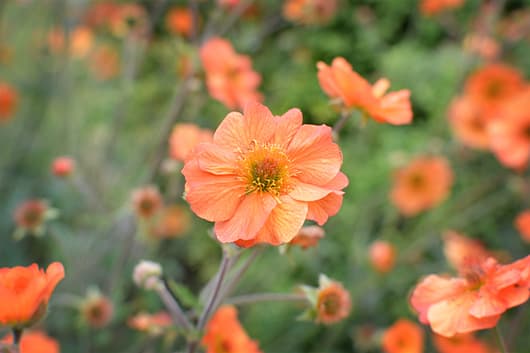At it’s best:
There’s a delicious pop of colour in our containers at The Garden Barn at the moment and it’s coming from one of our current favourite plant picks – Geum ‘Mai Tai’ from the Cocktails Series – which has got us thinking about this reliably attractive, though somewhat unappreciated plant.
The large, scarlet blooms of Geum ‘Mrs Bradshaw’ have been around for more than 100 years and are probably the most well-known of all the hybrids, especially since having been championed by Geoff Hamilton during his tenure as presenter of Gardeners’ World in the 1980’s and 90’s, but geums are back with a bang and we thought it time to share our experience and fondness for this versatile and colourful genus.
Geums in general are forgiving and easy-to-grow. At their best from late-spring to mid-summer with some varieties flowering well into autumn.
Originally hailing from arctic and temperate regions of Europe, America, New Zealand and Asia, they are native to mountainous landscapes and woodland edges, especially where there are streams and moist meadows. Our British native types are the subtly nodding bells of Geum rivale (Water Avens) and the delicate, buttercup blossom of Geum urbanum (Wood Avens), which as their monikers suggest are found near water and woods!
Whilst our UK natives are naturally discreet, though none the less charming, modern hybrids are certainly more eye-catching with larger, often quite brightly coloured, saucer-shaped blooms that can be singles, semis or doubles. These unsung heroes tend towards the warmer end of the spectrum, ranging from reds through oranges, peaches, pinks and yellows, so they look great paired with blooms which are in a similar tonal range or by contrast, on the opposite side of the colour wheel (think blues, blue-greens and violet).

When and Where:
These hardy perennials can be deciduous, semi-evergreen or evergreen depending on variety (especially the case during mild winters) and their free-flowering, clump-forming, naturalistic habits make them excellent plants to de-formalise an overly regimented border and perfect for cottage gardens and containers.
Best planted in moist soils where they will thrive, geums will take happily to most soil conditions, though they won’t put on a great show in very dry situations. As you may guess, rivale types (water avens) are most at home in moist soils and will tolerate shade better than their showier cousins, who prefer full sun.
Most geums mature to around 50cms so work well when planted in the front or middle of a border.
Whilst they occasionally spread by stolons, they respond well to being lifted and divided every 3 years or so, in spring or autumn.
Tolerance and Resistance:
Geums are generally moderately drought-tolerant, once established in the landscape, and are untroubled by pests and disease. You may find them attacked by aphids occasionally, but without much damage caused.
Under very dry conditions powdery mildew may form on mature leaves. These can simply be removed to encourage healthy new leaves to form.
Wildlife:
Geums are fantastic for pollinators, providing veritable feasting grounds for bees and butterflies. They are also resistant to the nibblings of deers and rabbits.
Curious Cuttings:
The roots of G. urbanum can be boiled up to create a chocolate-like drink. It can also be used as seasoning, making a great substitute for cloves (with a hint of cinnamon). Traditionally, it was used to flavour ale.
Explore more horticulture, garden design and landscaping inspiration by following our stories here and on social media, click the icons below to find us on your favourite platform.


